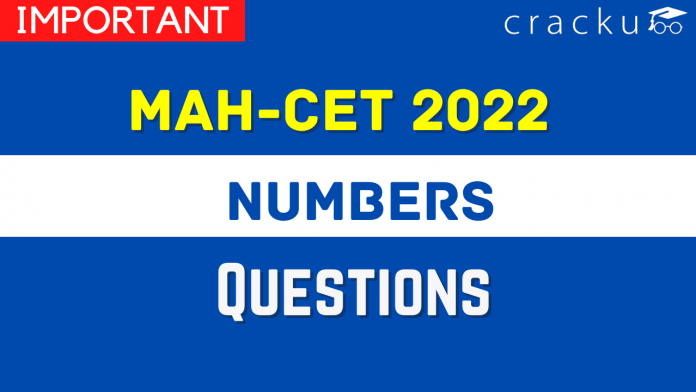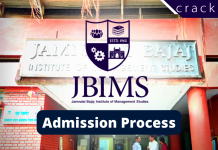Here you can download the important Number series questions PDF with solutions for MAH MBA CET by Cracku. These questions will help you to make practice and solve the Number series aptitude section questions in the MAH MBA CET exam. Utilize this best PDF practice set which is included answers in detail. Click on the below link to download the Number series questions PDF for MBA-CET 2022.
Download Number Series Questions for MBA-CET PDF
Enroll to MAH-CET Crash Course
Question 1: What will come in the place of question mark (?) in the following series?
2 9 28 65?
a) 96
b) 106
c) 126
d) 130
e) None of these
1) Answer (C)
Solution:
Each number is of the form $(n^3+1)$ where $n$ is a natural number
$1^3+1$ = 2
$2^3+1$ = 9
$3^3+1$ = 28
$4^3+1$ = 65
$5^3+1$ = 126
=> Ans – (C)
Question 2: What will come in place of the question mark (?) in the following number series?
9 10 39 220 ? 14382
a) 1589
b) 1598
c) 1958
d) 1985
e) 1835
2) Answer (A)
Solution:
The pattern followed is :
9 $\times 1 + 1^2$ = 10
10 $\times 3 + 3^2$ = 39
39 $\times 5 + 5^2$ = 220
220 $\times 7 + 7^2$ = 1589
1589 $\times 9 + 9^2$ = 14382
Question 3: What will come in place of the question mark (?) in the following number series?
121 238 472 ? 1876 3748
a) 1008
b) 948
c) 944
d) 940
e) 1005
3) Answer (D)
Solution:
Each number is multiplied by 2 and then 4 is subtracted from it.
121 $\times 2 – 4$ = 238
238 $\times 2 – 4$ = 472
472 $\times 2 – 4$ = 940
940 $\times 2 – 4$ = 1876
1876 $\times 2 – 4$ = 3748
Question 4: What will come in place of the question mark (?) in the following number series?
44 ? 99 148.5 222.75 334.125
a) 44
b) 55
c) 66
d) 33
e) 35
4) Answer (C)
Solution:
Each number is multiplied by $\frac{3}{2}$
44 $\times \frac{3}{2}$ = 66
66 $\times \frac{3}{2}$ = 99
99 $\times \frac{3}{2}$ = 148.5
148.5 $\times \frac{3}{2}$ = 222.75
222.75 $\times \frac{3}{2}$ = 334.125
Question 5: What will come in place of the question mark (?) in the following number series?
33 16.5? 24.75 49.5 123.75
a) 18.5
b) 16.5
c) 8.5
d) 8.25
e) None of these
5) Answer (B)
Solution:
The pattern followed is :
33 $\times \frac{1}{2}$ = 16.5
16.5 $\times \frac{2}{2}$ = 16.5
16.5 $\times \frac{3}{2}$ = 24.75
24.75 $\times \frac{4}{2}$ = 49.5
49.5 $\times \frac{5}{2}$ = 123.75
Question 6: What will come in place of the question mark (?) in the following number series?
20 23 30 43 64 ?
a) 95
b) 90
c) 100
d) 105
e) 96
6) Answer (A)
Solution:
Numbers of the form $n^2 – (n-1)$ are added, where $n$ is an integer starting from 2
23 $+ 2^2 – 1$ = 23
23 $+ 3^2 – 2$ = 30
30 $+ 4^2 – 3$ = 43
43 $+ 5^2 – 4$ = 64
64 $+ 6^2 – 5$ = 95
Question 7: What should come in place of the question mark (?) in the following number series?
1, 5, 17, 53, 161, 485, ?
a) 1168
b) 1254
c) 1457
d) 1372
e) None of these
7) Answer (C)
Solution:
The pattern here followed is :
1 * 3 + 2 = 5
5 * 3 + 2 = 17
17 * 3 + 2 = 53
53 * 3 + 2 = 161
161 * 3 + 2 = 485
485 * 3 + 2 = 1457
Question 8: What approximate value should come in place of the question mark (?) in the following question?
$54.786 \div 10.121 \times 4.454 = ?$
a) 84
b) 48
c) 118
d) 58
e) 24
8) Answer (E)
Solution:
Expression : $54.786 \div 10.121 \times 4.454 = ?$
= $\frac{55}{10} \times 4.5$
= $24.75 \approx 24$
Question 9: What should come in place of the question mark (?) in the following number series?
2 5 11 23 47 95 ?
a) 168
b) 154
c) 191
d) 172
e) None of these
9) Answer (C)
Solution:
The pattern here followed is :
2 * 2 + 1 = 5
5 * 2 + 1 = 11
11 * 2 + 1 = 23
23 * 2 + 1 = 47
47 * 2 + 1 = 95
95 * 2 + 1 = 191
Question 10: What should come in place of the question mark (?) in the following number series?
1 4 14 45 139 422 ?
a) 1268
b) 1234
c) 1272
d) 1216
e) None of these
10) Answer (C)
Solution:
The pattern here followed is :
1 * 3 + 1 = 4
4 * 3 + 2 = 14
14 * 3 + 3 = 45
45 * 3 + 4 = 139
139 * 3 + 5 = 422
422 * 3 + 6 = 1272
Take Free MAH-CET mock tests here
Question 11: What is the least number to be added to 2530 to make it a perfect square?
a) 50
b) 65
c) 75
d) 80
e) None of these
11) Answer (E)
Solution:
We know that $50^2 = 2500$ and $51^2 = 2601$
$\because$ 2500 < 2530 < 2601
$\therefore$ Required number = 2601 – 2530 = 71
Question 12: What would be the compound interest accrued on an amount of Rs. 9,000 at the rate of 11 p.c.p.a. in two years?
a) Rs. 2089.90
b) Rs. 2140.90
c) Rs. 2068.50
d) Rs. 2085.50
e) None of these
12) Answer (E)
Solution:
$C.I. = P [(1 + \frac{R}{100})^T – 1]$
= $9000 [(1 + \frac{11}{100})^2 – 1]$
= $9000 [(1.11)^2 – 1]$
= $9000 \times (1.2321 – 1)$
= $9000 \times 0.2321$ = Rs. $2,088.90$
Question 13: 16 8 12 30 ? 472.5
a) 104
b) 103
c) 106
d) 105
e) None of these
13) Answer (D)
Solution:
Odd multiples of $\frac{1}{2}$ are multiplied
16 $\times \frac{1}{2}$ = 8
8 $\times \frac{3}{2}$ = 12
12 $\times \frac{5}{2}$ = 30
30 $\times \frac{7}{2}$ = 105
105 $\times \frac{9}{2}$ = 472.5
Question 14: 2, 5, 12, 27, 58, ?
a) 122
b) 121
c) 123
d) 120
e) None of these
14) Answer (B)
Solution:
Each number is multiplied by 2 and then consecutive natural numbers are added
2 $\times 2 + 1$ = 5
5 $\times 2 + 2$ = 12
12 $\times 2 + 3$ = 27
27 $\times 2 + 4$ = 58
58 $\times 2 + 5$ = 121
Question 15: 18 19.7 16.3 23.1 9.5 ?
a) 36.5
b) 36.8
c) 36.7
d) 36.9
e) None of these
15) Answer (C)
Solution:
The pattern is :
18 $+ 1.7 \times 2^0$ = 19.7
19.7 $- 1.7 \times 2^1$ = 16.3
16.3 $+ 1.7 \times 2^2$ = 23.1
23.1 $- 1.7 \times 2^3$ = 9.5
9.5 $+ 1.7 \times 2^4$ = 36.7
Question 16: 68, ?, 77, 104, 168, 293
a) 69
b) 70
c) 68
d) 74
e) None of these
16) Answer (A)
Solution:
Cubes of consecutive natural numbers are added
68 $+ 1^3$ = 69
69 $+ 2^3$ = 77
77 $+ 3^3$ = 104
104 $+ 4^3$ = 168
168 $+ 5^3$ = 293
Question 17: In how many different ways can the numbers ‘256974’ be arranged, using each digit only once in each arrangement, such that the digits 6 and 5 are at the extreme ends in each arrangement?
a) 48
b) 720
c) 36
d) 360
e) None of these
17) Answer (A)
Solution:
Case 1 : 6 at left end and 5 is at right end : 6 _ _ _ _ 5
Now, four empty places can be filled by 2,9,7 and 4 in = $4!$ ways
= $4 \times 3 \times 2 \times 1 = 24$
Case 2 : 6 at right end and 5 at left end : 5 _ _ _ _ 6
Similarly, no. of ways = $4!$
= $4 \times 3 \times 2 \times 1 = 24$
$\therefore$ Total no. of ways = $24 + 24 = 48$
Question 18: What will come in place of both the question marks (?) in the following question ?$\frac{(?)^{0.6}}{104}=\frac{26}{(?)^{1.4}}$
a) 58
b) -48
c) -56
d) 42
e) -52
18) Answer (E)
Solution:
$\frac{(x)^{0.6}}{104}=\frac{26}{(x)^{1.4}}$
${(x)^{0.6}} * {(x)^{01.4}}$ = 104*26
${(x)^{2}}$ = 104*26
x = ±52
Question 19: Out of the fractions $\frac{1}{2}, \frac{7}{8}, \frac{3}{4}, \frac{5}{6}$, and $\frac{6}{7}$ what is the difference between the largest and smallest fractions ?
a) $\frac{7}{13}$
b) $\frac{3}{8}$
c) $\frac{4}{7}$
d) $\frac{1}{6}$
e) None of these
19) Answer (B)
Solution:
Given values are ,
$\frac{1}{2}$ = 0.5
$\frac{7}{8}$ = 0.87
$\frac{3}{4}$ = 0.75
$\frac{5}{6}$ = 0.83
$\frac{6}{7}$ = 0.86
∴ Required difference = $\frac{7}{8}$ – $\frac{1}{2}$ = (7-4)/8 = 3/8
Question 20: If $(11)^{3}$ is subtracted from $(46)^{2}$ . what will be the remainder?
a) 787
b) 785
c) 781
d) 783
e) None of these
20) Answer (B)
Solution:
Here
$(46)^2$ = 2116
$(11)^3$ = 1331
So, 2116 – 1331 = 785





